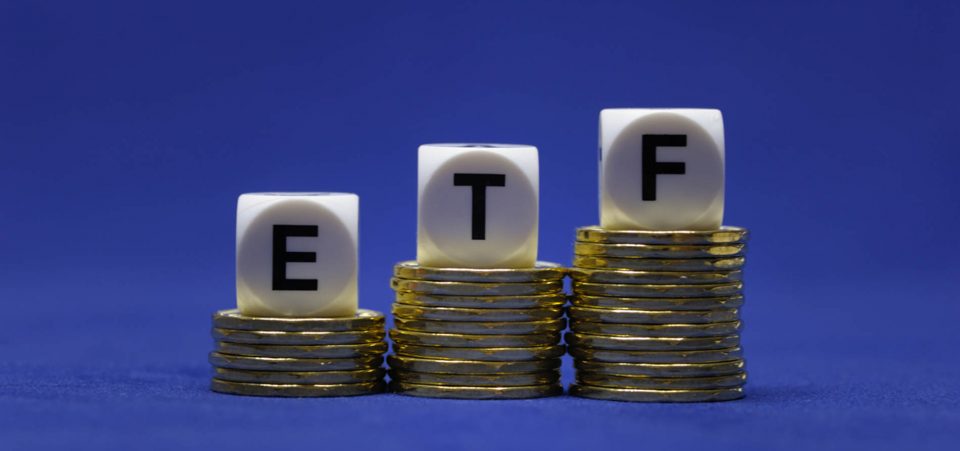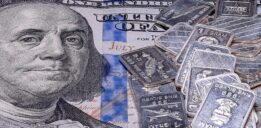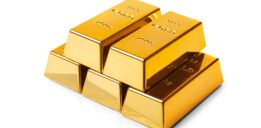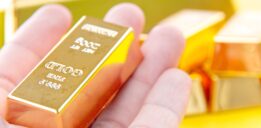The Best Gold ETF Holdings for Gold Bugs
Exchange-traded funds (ETFs) are all the rage; they have been for awhile. March 2017 alone saw $66.27 billion rush into American ETFs, which was the 38th straight month of inflows. More investors are choosing to forgo fundamental analysis and dive into a well-diversified pool of underlying equities or index trackers, hassle-free. My gold ETF list 2017 will help investors sort the wheat from the chaff, hopefully providing you with the information you need to find the top gold ETFs available to gold investors.
Before we get on with the top gold ETF 2017 list, why are ETFs becoming so popular? Have people become too lazy to research their own investment holdings? Not exactly.
For one, gold ETFs are more diversified and liquid than individual (junior) stocks. This has been well received by investors. In fact, in 2016, seven of the top 10 most active securities in America were ETFs; only three were individual equities. According to Credit Suisse Group AG (VTX:CSGN), ETF volume has risen 50% over the past few years, while individual shares could only muster a seven-percent gain. Clearly, investors prefer a diversified basket of sector leaders over the heightened individual risk that owning a single equity provides. (Source: “Stocks Are No Longer the Most Actively Traded Securities in Stock Markets,” Bloomberg, January 12, 2017.)
Another reason is plain old convenience. For investors looking to build a mini-portfolio of their own, questions arise about which stocks to buy, how to weight them, how to rebalance, etc. With ETFs, all the work is done for you. Investors can check the weightings before purchasing, and automatic rebalancing occurs at fixed times along the ETF’s life cycle. There’s no risk of slippage due to faulty logic, and costs are much lower than mutual funds (similar to individual stock trades).
There’s little to dislike (unless you’re a fund manager).
What Are the Benefits of Investing in Gold ETFs?
Among the most popular of all the commodity ETFs, gold is considered both a currency and a hedge against political and socioeconomic risk. It’s the perfect hedge against high inflation and currency debasement. For those reasons alone, gold continues to be a mainstay in millions of investment portfolios worldwide.
Far from just a portfolio hedge, gold has historically gone through cycles during which huge investment gains can be realized. This has been true since Richard Nixon completely severed the U.S. dollar’s partial backing to gold in August 1971, allowing the price of gold to float freely against the U.S. dollar.
For example, from August 1971 to January 1980, gold prices rose from $42.00 per ounce to a high of $850.00 per ounce. That’s an astounding gain of 1923%! More recently, between April 2001 and August 2011, gold prices rose from $260.00 per ounce to just over $1,900, for a decade-long gain of 630.7%.
So, as we clearly see, gold is unique in that it can serve as a hedge against economic uncertainty as well as providing substantial capital gains during cyclical bull cycles.
Fortunately, unlike the days of the 20th century, investors now have the option of investing in gold ETF products, as opposed to holding it in physical possession.
What Types of Gold ETFs Are Available?
One of the primary ways gold ETFs differentiate themselves is through the leverage they employ. Some of the more popular instruments like iShares Gold Trust(ETF) (NYSEARCA:IAU) use leverage on a 1:1 basis with the spot gold price. This ensures the returns of the fund on any given day, month, or year are almost exactly the same percentage returns of the underlying spot gold price, minus expense fees.
Other gold ETFs are far more aggressive. For example, Credit Suisse AG – VelocityShares 3x Long Gold ETN (NASDAQ:UGLD) employs triple leverage, which enhances the gains or losses in gold prices by 300% in a given time period. Obviously, this type of investment is not suitable for many portfolios.
This is especially true for investors looking to hang onto their positions for extended periods of times. Leveraged ETFs are known to be prone to “beta slippage” over time, which will erode gains the longer it is held.
Beta slippage is a normal mathematical concept in which gains or losses in leveraged assets produce asymmetrical returns due to the laws of compounding. To better understand this concept, let’s look at the following example:
If a non-leveraged gold ETF, mimicking the gold price exactly, rose five percent the first day, and fell four percent on the second day, the underlying asset would revert back to its original price: (1 + 0.05) × (1 – 0.04) = 1.008
Now, in a double leveraged asset, the math works out differently: (1 + 0.1) × (1 – 0.08) = 1.012
In other words, the gains and losses in leveraged ETFs are not identical, even though the same percentage gains and losses would render the performance neutral in a non-leveraged gold ETF. Over weeks and months of gains and losses, this adds up. The performance of leveraged ETFs can seriously underperform the underlying asset. For this reason, it is not recommended to hold leveraged ETFs for longer than a few weeks.
What Are the Differences Between ETF Products?
When it comes to gold ETFs, investors need to know that not all products are the same. There are subtleties in the underlying indexes they track. These differences can have a material effect on investment gains.
For example, the popular SPDR Gold Trust (ETF) (NYSEARCA:GLD) is backed by millions of ounces of gold, representing a certain percentage of every share. As such, this ETF tracks the spot gold price to the tick and, in case of custodian insolvency, the trust would maintain control of the allocated bars in its possession.
Still, other gold ETFs don’t hold any allocated gold at all. Their main underlying asset might be gold futures contract trading on the Chicago Mercantile Exchange (CME), or the DBIQ Optimum Yield Gold Index Excess Return (also re-investing short-term interest income). These products will mostly track the price of spot gold, but not as precisely as the SPDR Gold Trust ETF itself; something to consider.
Lastly, investors need to be aware of the differences between exchange-traded funds and exchange-traded notes (ETNs). Both products look and trade the same way, and the fees are similar. The difference lies in the underlying asset of each. ETFs, of course, are backed by physical gold, equities, futures contracts, or other derivatives giving the ETF true worth. ETNs are like bonds or unsecured notes from the issuer. An ETN doesn’t have the same underlying asset backing of an ETF and, should the issuer go bankrupt, investors would lose all their principal.
Ensuring the creditworthiness of the underlying issuer is key to ensuring the viability of an ETN investment’s quality.
Are There Tax Advantages Associated with Different Products?
Yes, there are differences in tax advantages between different products. Because ETNs are debt instruments and don’t hold the underlying asset, they enjoy the benefit of being taxed at long-term capital gains rates if held long term (for more than a year). Taxes are also incurred when the instrument is sold, and not on a yearly market-to-market basis.
Since ETN tax payments are deferred, investors need to plan carefully to ensure they can afford the tax liability when the instrument is sold. If large capital gains are incurred, this will be a very meaningful sum, and likely owed to the tax authorities as one lump-sum payment. This is different than the tax liability of ETFs, which are paid incrementally (yearly). Please contact your trusted tax adviser for specific details of these tax liabilities.
Individual tax circumstances vary but, by almost any account, ETNs are the superior product. As ETFs and ETNs both trade almost identically to the underlying gold price, long-term investors would be wise to grant ETNs serious consideration.
Gold ETF List 2017
These ETFs are assembled in order of their current popularity in the marketplace.
Gold ETFs
| Symbol | ETF Name |
| GLD | SPDR Gold Trust (ETF) |
| IAU | iShares Gold Trust(ETF) |
| DGL | PowerShares DB Gold Fund (ETF) |
| OUNZ | Merk Gold Trust |
| SGOL | ETFS Gold Trust |
(Source: “Gold ETF List,” ETF Database, last accessed May 11, 2017.)
Leveraged Gold ETFs
| Symbol | ETF Name |
| UGLD | Credit Suisse AG – VelocityShares 3x Long Gold ETN |
| UGL | ProShares Ultra Gold (ETF) |
| NUGT | Direxion Shares Exchange Traded Fund Trust |
| JNUG | Direxion Shares Exchange Traded Fund Trust |
| DGP | DB Gold Double Long ETN |
Leveraged & Non-Leveraged Inverse Gold ETFs
| Symbol | ETF Name |
| DZZ | DB Gold Double Short ETN |
| DGLD | Credit Suisse AG – VelocityShares 3x Inverse Gold ETN |
| GLL | ProShares UltraShort Gold (ETF) |
| DGZ | DB Gold Short ETN |
| GDX | Market Vectors Gold Miners ETF |
Best Gold ETF 2017
There is no “best gold ETF,” per se. What gold ETF to own really depends on individual investor temperament, investing timelines, expected price appreciation, and more. Gold Miner ETFs are more leveraged to gold prices, so they tend to appreciate faster when gold prices move up. In more neutral-to-bearish markets, the defensive nature of a pure gold tracker is generally safer. Many of these products are similar, but track different index variants. Some even offer physical redemptions, for those wishing to take possession.
One thing is for certain: regardless of your favorite investment vehicle, gold investors everywhere will be happy once the gold bull comes roaring back once again.






